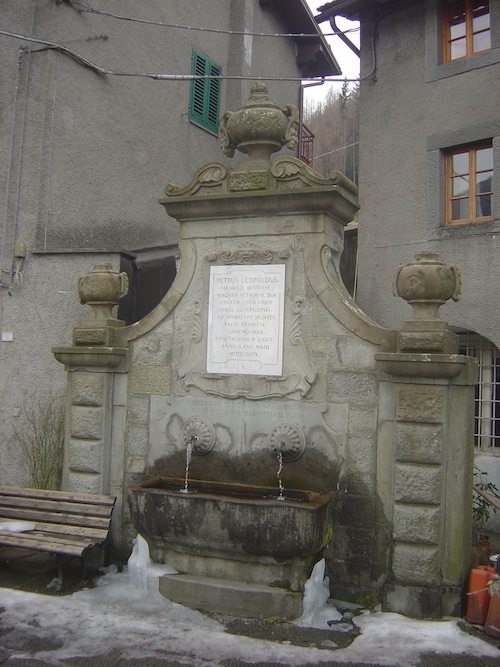Fontana del Ponte Sestaione

In some cases Ximenes designed monumental works that responded above all to decorative and celebratory needs. This was the case of the two twin fountains placed opposite each other on the Lima bridge (destroyed with the bridge during the Second World War), and this is especially true for the one near the Sestaione bridge. This can probably be attributed to its location, a few steps from the most demanding and majestic work of the entire road: the bridge over the Sestaione. From here, however, the most arduous and tiring route towards Abetone began, therefore the place could not be without a fountain "to refresh travellers and their animals before the final climb or to restore them before the descent towards San Marcello". It was built a little back from the road on a paved clearing, a convenient stop for wayfarers. The fountain was also entrusted with the task of celebrating the construction of the majestic bridge and above all its patron, the Grand Duke Pietro Leopoldo, through a marble plaque with an epigraph praising the prince. It was completed in 1779 but the water supply pipe was only completed in 1781. The structure is in sandstone with an imposing façade delimited by two pilasters with rectangular bosses with capitals that support semi-spherical vases with worked handles; mixtilinear cymatiums and, crowning everything, a third vase with festooned handles from which flames emerge (the two lateral vases also had them but they have been lost). At the bottom is the monolithic basin with irregular curvature that rests on a linear base and on two lion's paw supports. The basin is surmounted by a horizontal slab that holds two sculpted rosettes from which the water spouts emerge, now metal, which were originally in terracotta. The slab bears the phrase “O PELLEGRIN SE DEL SENTIER SEI LASSO/ FERMATI BEVERI E POI RADDOPPIA IL PASSO” carved into it, of a popular nature and believed by many to be later than the fountain. Above this slab, in the centre of the head, is a mixtilinear stone cartouche, moulded with volutes, modelled in the upper part with a mask, which contains the rectangular marble plaque with the inscription. Both the cartouche and the slab have LXF engraved on them, which stands for “Leonardo Ximenes Fecit”. Looking at it as a whole, the fountain appears to be divided in two, as the upper part is much more refined and cared for than the lower one. The basin part actually shows a rather rough workmanship, and does not seem to be by the same hand as the part above. It may be that Ximenes concentrated more on the celebratory part, towards the Grand Duke, and towards himself indirectly, neglecting the “utilitarian” part; it has also been assumed that the lower part is later, the current one having replaced the original. Location Ponte Sestaione

 Italiano
Italiano